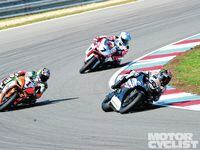It starts simply enough. When we begin to ride, there are only two basic things we can change: speed and direction. As our skills expand, we quickly escalate to a complex system of those elements: the six controls at our fingers and feet have 37 combinations of on/off, use/rest. The multiples begin to muddy the arithmetic because there are 19 different ways to manipulate those six controls. But even that isn’t all black-and-white, because 17 of them are also variable in their adjustability; only two—gear changes up or down—are hard-edged. In other words, considering the variety of applications available for steering inputs and applying either of the brakes, throttle and clutch, there are literally _hundreds _of combinations requiring a deft touch to create _smooth _rider inputs. There’s that word again: smooth.
You can work out all the combos on paper if you like—I’ve already done that. Some combinations—like applying full gas and full brakes—would be pointless, destructive or dangerous. Learning to not stab the front brake lever at low speed and to simultaneously pull in the clutch so it doesn’t stall the bike would be useful to learn.
To illustrate this, compare two current World Superbike riders at the top of their game: Marco Melandri and Carlos Checa. Melandri’s bike, the Yamaha YZF-R1, is well known for its handling: It squirms, twitches and hops around beneath him as though it had a mind of its own. On the other hand, Checa’s Ducati 1098R remains fluid and seamless, even past the point when its tires have gone off. Even looking back on superstar Troy Bayliss’ rides on the Ducati, Checa still looks better. Those twitches cost time; not much, just a hundredth of a second or two. But in that arena, hundredths add up to a tenth or two, and that is usually the margin of difference from lap to lap. The fact is, you can be very rough with the levers, bars and twistgrip and still maintain world-class, podium-finishing control over the bike.
As a street rider, you’ve been in the situation at some time where the clutch release and throttle were just right when leaving a stoplight or a gear change was perfectly seamless. You wondered how you did it … only to botch it completely the next time. I’m betting you tried to make your fingers and feet do exactly the same thing they did before, trying to coax a non-existent muscle memory into recreating those conditions.
I’m also betting when you nailed it, some, but not all, of your attention was on your fingers and feet at the controls. Not that you were ignoring the controls or their feel, but your attention wasn’t glued to them either. Pulling away from the stop sign cleanly is what you intended and it worked. Paying more attention to something that isn’t going right is normal. When it comes to nailing it, less attention usually works better. Too much attention on your hands and feet creates anticipation, which slows your ability to respond or has you jumping ahead; either way you mistime the inputs. Our hands and feet aren’t where the desired results lie. When putting the bike in motion, it’s the movement of the bike that is important. I’d love to do an experiment teaching new riders how to use the clutch with an absolutely silent engine.
Simply putting a rider’s attention on the result rather than the mechanics often resolves his notchy riding. This is an element of training the muscles; it’s one thing to have the concept of good throttle control and quite another to put this into practice consistently and perfectly. That’s the reason it’s been our first drill at the school for 30 years. Coaching riders who intellectually understand but can’t apply the one simple rule of good throttle control is very interesting; they firmly believe they are doing it right. It takes a trained set of eyes to help pick apart the problems and accelerate the learning curve.













/cloudfront-us-east-1.images.arcpublishing.com/octane/HXOUJXQWA5HBHGRO3EMJIGFMVI.jpg)

/cloudfront-us-east-1.images.arcpublishing.com/octane/3TIWWRV4JBBOLDVGRYECVVTA7Y.jpg)
/cloudfront-us-east-1.images.arcpublishing.com/octane/KIX5O23D5NAIBGFXBN3327DKZU.jpg)
/cloudfront-us-east-1.images.arcpublishing.com/octane/7GJYDUIPXRGMTMQKN6ONYOLBOU.jpg)
/cloudfront-us-east-1.images.arcpublishing.com/octane/MUQLOVLL2ZDGFH25ILABNBXKTI.jpg)
/cloudfront-us-east-1.images.arcpublishing.com/octane/TNOU5DNE2BC57MFPMGN2EIDXAM.jpg)
/cloudfront-us-east-1.images.arcpublishing.com/octane/GTCXACQGJ5HAPDTGWUQKDEH44E.jpg)
/cloudfront-us-east-1.images.arcpublishing.com/octane/S35YGSEMEZB4BLTDJTSZPF4GLA.jpg)
/cloudfront-us-east-1.images.arcpublishing.com/octane/5UOT6HPX2JFMRJAX6EH45AR4MQ.jpg)
/cloudfront-us-east-1.images.arcpublishing.com/octane/OKWOJWAKP5EP3OACCRRWPCIX2Q.jpg)
/cloudfront-us-east-1.images.arcpublishing.com/octane/2WF3SCE3NFBQXLDNJM7KMXA45E.jpg)
/cloudfront-us-east-1.images.arcpublishing.com/octane/G4MG6OUCJNBSHIS2MVVOTPX65E.jpg)
/cloudfront-us-east-1.images.arcpublishing.com/octane/IIGGWFOTOJGB7DB6DGBXCCMTDY.jpg)
/cloudfront-us-east-1.images.arcpublishing.com/octane/QSTCM6AVEZA5JJBUXNIQ3DSOF4.jpg)
/cloudfront-us-east-1.images.arcpublishing.com/octane/U4I7G625B5DMLF2DVIJDFZVV6M.jpg)
/cloudfront-us-east-1.images.arcpublishing.com/octane/B6XD6LS6IVCQPIU6HXDJSM3FHY.jpg)
/cloudfront-us-east-1.images.arcpublishing.com/octane/ICL63FEDDRDTTMINYICCEYGMDA.jpg)
/cloudfront-us-east-1.images.arcpublishing.com/octane/FCGZHQXRBZFLBAPC5SDIQLVF4I.jpg)
/cloudfront-us-east-1.images.arcpublishing.com/octane/WNOB6LDOIFFHJKPSVIWDYUGOPM.jpg)

/cloudfront-us-east-1.images.arcpublishing.com/octane/X33NU3E525ECRHXLNUJN2FTRKI.jpg)
/cloudfront-us-east-1.images.arcpublishing.com/octane/6KKT5NNL2JAVBOXMZYS5ZO76YA.jpg)
/cloudfront-us-east-1.images.arcpublishing.com/octane/J5RKG5O455GMPGQRF2OG6LRT7A.jpg)